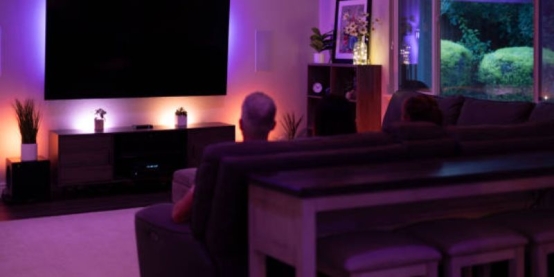Movies
Is Your Audio Ready? The Essential List Of Must-Watch Dolby Atmos Movies
Imagine sitting in your living room, hearing a helicopter overhead, rain falling, or footsteps behind you—not just around you. That leap from 2D surround to fully immersive 3D audio is what Dolby Atmos offers. This guide shows you how to understand, experience, and enjoy Atmos movies at home.
Imagine sitting in your living room, hearing a helicopter overhead, rain falling, or footsteps behind you—not just around you. That leap from 2D surround to fully immersive 3D audio is what Dolby Atmos offers. This guide shows you how to understand, experience, and enjoy Atmos movies at home.
What Is Dolby Atmos and Why Does It Matter
Dolby Atmos is a spatial audio technology developed by Dolby Laboratories that adds height and object-based audio to the sound mix. Traditional surround systems (5.1 or 7.1) assign sounds to fixed channels (e.g. left, right, rear). Atmos takes a different approach: each effect or voice can be treated as a discrete “object” placed or moved freely in three-dimensional space, including above the listener.

That means filmmakers and sound designers can precisely position sounds—an insect buzzing, a raindrop, a helicopter—anywhere in the room, not constrained to static speaker zones. Because of that flexibility, audio in Atmos is more realistic, immersive, and capable of surprising you with depth and directionality.
Atmos is now widely supported across cinemas, home sound systems, soundbars, streaming platforms, and even headphones and mobile devices.
How to Know If Your Setup Supports Dolby Atmos
Devices That Commonly Support Atmos
AV receivers/home theatre processors: Many modern AVRs support Atmos decoding and have connectors for height or overhead speakers (e.g. ".2" or ".4" in system naming).
Soundbars: Flagship models (e.g. Sonos Arc, Samsung Q series) often use upward-firing drivers to simulate height effects.
TVs / streaming boxes: Some smart TVs pass Atmos bitstreams via HDMI eARC to your audio system. Devices like the Apple TV 4K, Fire TV Cube, and high-end Android TV boxes often support Atmos output.
Headphones/mobile: Atmos can be delivered in binaural rendering (virtual spatial audio) via software like Windows Sonic, Dolby Atmos for Headphones, or Apple’s Spatial Audio.
How To Check That a Movie Is Playing In Atmos
On streaming apps (Netflix, Disney+, Prime Video, etc.), look for the “Dolby Atmos” badge or icon on the title or in audio settings.
On your AVR or TV, check the audio format display—if it shows “Dolby Atmos,” “Atmos,” or “Dolby TrueHD + Atmos,” that indicates Atmos playback.
Some TVs show small on-screen badges during playback when Atmos is active.
Common Mistakes That Block Atmos
Using non-certified HDMI cables (e.g. “High Speed” instead of “Premium High Speed / Ultra High Speed”) may choke the data bandwidth.
Not enabling passthrough or eARC on the TV, which can result in downmixing Atmos to stereo or 5.1.
Selecting the wrong audio track (e.g. choosing “Stereo” or “5.1” instead of the Atmos track).
Devices in the chain (TV or switch box) that strip metadata or don’t pass bitstreams.
If Atmos looks available in the app but your system isn't showing it, work backwards through the chain (TV → AVR → soundbar) to find where the signal is being lost.
Where to Watch Dolby Atmos Movies
Streaming Platforms
Netflix: Only on the premium tier; not all titles support Atmos.
Disney+: Many of their original titles, including Marvel, Pixar, and Star Wars, offer Atmos mixes.
Apple TV+: Almost every original Apple production is encoded in Atmos.
Prime Video: Atmos is present, but more inconsistently across their catalogue.
Other services / regional ones: Some niche or local platforms may carry Atmos-encoded films.
Physical Media
Nothing beats 4K Ultra HD Blu-ray or Blu-ray discs that carry lossless Dolby TrueHD + Atmos tracks. These ensure maximum audio fidelity and full dynamic range (no compression).
Devices
To receive Atmos from streaming services or discs, you’ll want compatible hardware—smart TVs with eARC, dedicated media players (Apple TV 4K, Roku Ultra, Nvidia Shield), or game consoles that support Atmos output.
Must-Watch Dolby Atmos Movies (2025 Edition)
Here is a curated list of standout Dolby Atmos movies, organised by experience or genre. Each entry includes release year, where to stream/watch, and what makes its Atmos mix exceptional.

Action & Adventure
Top Gun: Maverick (2022)
Where to watch: Available on select streaming platforms or 4K UHD disc.
Atmos highlight: The aerial dogfights and jet flyovers shine in Atmos, enveloping you in spatial motion with precise height cues.
Mad Max: Fury Road (2015)
Where to watch: Often available on streaming or disc editions.
Atmos highlight: Explosive action cascades around and above you; engine noise, wind, and debris feel visceral.
John Wick: Chapter 4 (2023)
Where to watch: On streaming or UHD disc.
Atmos highlight: Weapon details, footsteps, and spatial ambience create intense directional immersion, especially in quiet scenes.
Sci-Fi & Fantasy
Dune: Part Two (2024/2025 release)
Where to watch: On select platforms or UHD disc.
Atmos highlight: The roar of sandworms and the delicate wind across desert dunes take full advantage of the vertical plane.
Blade Runner 2049 (2017)
Where to watch: Streaming or UHD disc.
Atmos highlight: Futuristic city ambience, distant traffic, and environmental effects stretch across the room.
Avatar: The Way of Water (2022)
Where to watch: Available on streaming or UHD disc.
Atmos highlight: Underwater audio layering, wildlife sounds, and cascading waterfalls benefit from height and surround space.
Superhero Blockbusters
Guardians of the Galaxy Vol. 3 (2023)
Where to watch: Disney+ or UHD disc.
Atmos highlight: Energy blasts, cosmic ambience, and music blend in three dimensions for a rich sonic ride.
The Batman (2022)
Where to watch: HBO Max or disc, where available.
Atmos highlight: Rain, rooftop echoes, and stealth movement sound sharply directional—height cues add depth to the city soundscape.
Avengers: Endgame (2019)
Where to watch: Disney+ or disc.
Atmos highlight: Epic battle sequences and spatial transitions between dimensions feel expansive.
Horror & Thriller
A Quiet Place (2018)
Where to watch: Streaming or disc.
Atmos highlight: Silence itself becomes part of the mix—when sound emerges, its placement is calculated and chilling.
IT Chapter Two (2019)
Where to watch: Streaming / disc.
Atmos highlight: Jump scares and distant whispers move around and above you, increasing tension.
Musical & Drama
Bohemian Rhapsody (2018)
Where to watch: Streaming or disc.
Atmos highlight: Live concert segments and music mixing feel enveloping—audience, stage, and instruments in 3D.
La La Land (2016)
Where to watch: Streaming or disc.
Atmos highlight: Jazz performances, spatial separation of instruments, and ambience immerse the listener in the scene.
Hidden Gems in Dolby Atmos
Here are some underrated or less-discussed Atmos films worth exploring for their sonic creativity:
1917 (2019) — masterful use of spatial transitions and ambient sound to match the “one-shot” camera journey.
Gravity (2013) — silence and echo in space, with directional alarms and debris pop in three dimensions.
Ready Player One (2018) — video game world layering, virtual environments, and action set pieces show off dynamic object-based audio.
Blade Runner 2049 — while already mainstream, its sound design is often cited in industry discussion as exemplary.
Mission: Impossible — Fallout (2018) — intense chase scenes, gunplay, and environmental effects benefit from height and surround fidelity.
These titles are often found on UHD discs or select streaming editions and reward careful listening.

How to Test & Calibrate Your Dolby Atmos System
Use Demo Clips
Search for Dolby Atmos demo videos or test scenes (on YouTube or Dolby’s site). These segments are engineered to sweep sound objects across your soundstage vertically, laterally, and diagonally.
Calibration Tips
Place height or upward-firing speakers correctly—angle and direction matter.
Use your AVR's auto-calibration (Audyssey, Dirac, etc.), but verify height channel levels manually.
In settings, turn off any "virtual surround" or "upmix" modes if your system supports native Atmos.
Confirm that the audio format is accurately passed through (Dolby Atmos, not a downmix).
Know Dolby Audio Vs. Truehd Vs. Atmos
Dolby Audio (or Dolby Digital): basic lossy surround mix (e.g. 5.1)
Dolby TrueHD: a lossless codec used on Blu-ray; Atmos often rides on top of a TrueHD track.
Dolby Atmos: the spatial metadata and object audio are mapped over or alongside existing tracks.
If you see “Dolby Audio” as the source, you’re not hearing Atmos.
Troubleshooting
If height effects are weak or nonexistent, check speaker wiring and verify they’re enabled in your AVR.
If no Atmos shows up even when titles are flagged, your chain may force downmix—check HDMI, enable eARC, turn off TV audio processing.
Mismatched speaker types or channel settings can confuse the renderer—ensure speaker sizes and distances are correctly set.
Pro Tips to Elevate the Dolby Atmos Experience
Room design matters: ceiling height, reflective surfaces, and speaker angles influence performance.
Up-firing vs. ceiling-mounted speakers: Up-firing speakers are easier to install, but dedicated ceiling speakers generally provide cleaner, more accurate overhead effects.
Use HDMI eARC: ensures uncompressed bitstreams with Atmos metadata pass from TV to AVR.
Tailor app settings: some streaming apps let you force the Atmos track; others require specific audio settings.
Headphones vs speaker systems: headphones deliver spatial Atmos via software rendering, but complete speaker systems provide true physical immersion.
What’s Next for Dolby Atmos and 3D Audio
Dolby Atmos is expanding beyond film. It is increasingly used for music (e.g. spatial audio on streaming services) and in gaming and VR environments. As immersive sound becomes more mainstream, investing in Atmos-ready hardware now provides future-proofing.
Streaming services and device makers are also experimenting with alternative spatial formats such as IAMF (Immersive Audio Model and Formats) and open audio models. These developments further push immersive audio adoption.
Sources
TV Shows
18 Must-Watch Science Shows For Curious Kids
September 8, 2025
Outfit Ideas
The Ultimate Guide To Dressing For Your Body Type
September 3, 2025
TV Shows
20+ TV Shows That Make You Laugh and Cry
September 12, 2025
Outfit Ideas
This One Trick Can Make Any Outfit Look More Expensive
August 29, 2025
TV Shows
The Best Office Laughs: Workplace Comedies You Can’t Miss
August 26, 2025
TV Shows
What Are The Best TV Shows To Watch With Tweens
September 5, 2025

Outfit Ideas
Cute Halloween Costumes For Boys And Girls
September 10, 2025

Movies
7 New Halloween Movies You Can’t Miss This Year
September 5, 2025

TV Shows
13 Best Feel-Good TV Shows For Stressful Days
September 7, 2025

Outfit Ideas
The Ultimate Guide To Styling A Classic White T-Shirt
August 30, 2025

Outfit Ideas
The Ultimate Guide To Dressing For Your Body Type
September 3, 2025

Celebrity
Child Stars From The 2000s: Where Are They Now (Recent Photos)
August 21, 2025